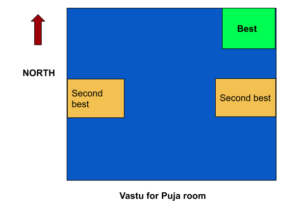When it comes to the temple or prayer area in a home, there are several Vastu Shastra guidelines that should be followed, to ensure maximum positive effects for the home’s inhabitants. We examine the dos and don’ts
The temple at home, is a sacred place where we worship God. So, naturally, it must be a positive and peaceful place. The temple area, when placed according to Vastu Shastra, can bring health, prosperity, and happiness to the house and its occupants. Although a separate puja room would be ideal, this is not always possible in metropolitan cities, where there is space crunch. For such homes, you can consider wall-mounted mandir or small corner mandir as per your requirement.
How should a temple at home be constructed as per Vastu
When it comes to constructing the temple, do not place it directly on the floor. Instead, keep it on a raised platform or pedestal, advises Parmar. “The temple should be made of marble or wood. Avoid temples made from glass or acrylic. Do not clutter the temple. Ensure that you do not have multiple idols of the same God or Goddess, either in a seating or standing position in the temple. The idol or photos placed in the temple, should not be cracked or damaged, as it considered is inauspicious,” suggests Parmar.
Best direction to place your puja room at home

One should be able to perform poojas, wherever the temple is kept. During special poojas, the entire family tends to pray together. Hence, ensure that there is enough space for the family to sit down and pray. The temple area should have good and healthy flow of energy. So, keep it neat and clean, without dust or cobwebs and avoid stuffing the space with too many accessories. Above all, the temple should give you a feeling of serenity and calmness.
Dos and don’ts for decorating a temple at home
- The light or diya, should be placed on the right side of the person performing a pooja.
- Decorate the temple with fresh flowers. Light a few aroma candles, dhoop or incense sticks, to cleanse the area and create a divine ambiance.
- Photographs of the dead/ancestors, should not be kept in the temple.
- Create a small shelf near the temple, to place the incense, puja materials and holy books.
- Ensure that there are electric points near the temple, so that one can light up the temple during festive days.
Avoid keeping unnecessary items below the temple or dustbins in this area. - Some people keep the temple in the bedroom or kitchen. In such cases, hang a curtain in front of the temple, when you are not using the temple.
- Temple should not be against a wall that has a toilet behind it. It should also not be placed below a toilet on the upper floor.
- For the temple space, use white, beige, lavender or light yellow colours.
- The temple must be placed high, such that the feet of the idols placed should be at the level of the devotee’s chest. Never place the idol on the floor.
- Ideally, the idol should not be more than 10 inches.
If you are using a wooden temple, ensure a dome structure on its top. - Ensure that the entry towards the puja room has a threshold.
- If an idol is damaged, replace it and never keep broken idols in the temple.
- Do not store anything above the idols.
- A two-shutter door is ideal for a puja room, as per Vastu. In such cases, the idol should not be facing the door directly.
For water, use copper vessels only.
Best colours for a puja room as per Vastu
As already mentioned, to maintain the tranquility of a puja room, Vastu Shastra says that subtle colours are preferable. Whites, light blues and pale yellow are suitable. Avoid dark colours in a puja room. because these will not lend a sense of calm that is suitable for a prayer room. Similarly, use white marble or any light-coloured marble tiling for the flooring of your puja room.
Source: Housing News









